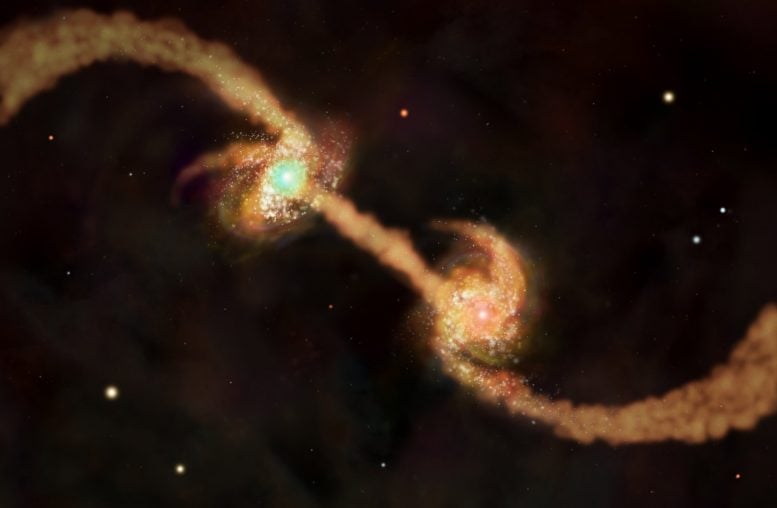
This illustration shows two spiral galaxies – each with supermassive black holes at their center – as they are about to collide and form an elliptical galaxy. New research shows that galaxies’ dark matter halos influence these mergers and the resulting growth of supermassive black holes. Credit: NASA/CXC/M.Weiss
Using data from the Sloan Digital Sky Survey and the ROSAT X-ray satellite’s all-sky survey, researchers from the Harvard-Smithsonian Center for Astrophysics detail a distinct relationship between the mass of a dark matter halo and the mass of a black hole.
Cambridge, Massachusetts – Every massive galaxy has a black hole at its center, and the heftier the galaxy, the bigger its black hole. But why are the two related? After all, the black hole is millions of times smaller and less massive than its home galaxy.
A new study of football-shaped collections of stars called elliptical galaxies provides new insights into the connection between a galaxy and its black hole. It finds that the invisible hand of dark matter somehow influences black hole growth.
“There seems to be a mysterious link between the amount of dark matter a galaxy holds and the size of its central black hole, even though the two operate on vastly different scales,” says lead author Akos Bogdan of the Harvard-Smithsonian Center for Astrophysics (CfA).
This new research was designed to address a controversy in the field. Previous observations had found a relationship between the mass of the central black hole and the total mass of stars in elliptical galaxies. However, more recent studies have suggested a tight correlation between the masses of the black hole and the galaxy’s dark matter halo. It wasn’t clear which relationship dominated.
In our universe, dark matter outweighs normal matter – the everyday stuff we see all around us – by a factor of 6 to 1. We know dark matter exists only from its gravitational effects. It holds together galaxies and galaxy clusters. Every galaxy is surrounded by a halo of dark matter that weighs as much as a trillion suns and extends for hundreds of thousands of light-years.
To investigate the link between dark matter halos and supermassive black holes, Bogdan and his colleague Andy Goulding (Princeton University) studied more than 3,000 elliptical galaxies. They used star motions as a tracer to weigh the galaxies’ central black holes. X-ray measurements of hot gas surrounding the galaxies helped weigh the dark matter halo, because the more dark matter a galaxy has, the more hot gas it can hold onto.
They found a distinct relationship between the mass of the dark matter halo and the black hole mass – a relationship stronger than that between a black hole and the galaxy’s stars alone.
This connection is likely to be related to how elliptical galaxies grow. An elliptical galaxy is formed when smaller galaxies merge, their stars and dark matter mingling and mixing together. Because the dark matter outweighs everything else, it molds the newly formed elliptical galaxy and guides the growth of the central black hole.
“In effect, the act of merging creates a gravitational blueprint that the galaxy, the stars, and the black hole will follow in order to build themselves,” explains Bogdan.
The paper describing this work has been accepted for publication in the Astrophysical Journal. This result relied on data from the Sloan Digital Sky Survey and the ROSAT X-ray satellite’s all-sky survey.
Headquartered in Cambridge, Massachusetts, the Harvard-Smithsonian Center for Astrophysics (CfA) is a joint collaboration between the Smithsonian Astrophysical Observatory and the Harvard College Observatory. CfA scientists, organized into six research divisions, study the origin, evolution, and ultimate fate of the universe.
Reference: “Connecting Dark Matter Halos with the Galaxy Center and the Supermassive Black Hole” by Ákos Bogdán and Andy D. Goulding, 18 February 2015, The Astrophysical Journal.
DOI: 10.1088/0004-637X/800/2/124
arXiv: 1502.05043









I may be naive, but I have not read any article about dark matter condensed in a way that it collapses and creates a black hole – a very black hole indeed. If you take enough of ordinary matter and compact it beyond a certain limit, a black hole is created. Since the dark matter only interacts gravitationally it ought to be able to create black holes just as well. Is there any research about this?
You are correct. The only reasonable conclusion is that black holes and dark matter are the same thing – ordinary matter. The only ordinary matter that fits the description of dark matter is neutrinos.
A comment on Dark Matter.
It certainly does exist and may be a rather simple but very exotic form of matter such as cluster ‘soup’ of super-gravitic free bosons that radiate force only so can’t be ‘seen’.
Hence ‘dark matter’ I believe is a dangerous misnomer.
‘dark force’ would be more appropriate as something that does not originate from ‘mass’ that many theoretical physicists have a regrettable fixed idea about.
I theorize: a dark force can exist and act over great ‘distances’. It’s effects cannot be measured on a local scale but requires methods of mensuration that preclude its direct detection.
If this force exists, then it would not rely on the existence of matter. An assumption in earth theoretical physics is that gravity is generated by matter. It’s perhaps more likely that gravity originates outside the universe and does flow /via/ matter and this agrees with observations. Gravity however may be proven to ‘leak’ into the universe where there are no observable masses in the same spatial location.
Matter’s apparent intimate relationship with gravity may not be entirely true